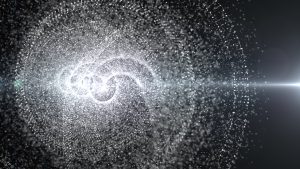The properties of neutrinos, created in the heart of stars and cosmic explosions, could be the key to unlocking some of the Universe’s biggest mysteries. It may sound like a coincidence, but it’s no exaggeration.
Neutrinos are called ‘ghost particles’ because they are elusive and can pass through matter without a trace. However, scientists have found ways to detect these elusive particles and have unlocked remarkable insights into the Universe. Neutrinos are fascinating because they allow us to study events that are invisible to other forms of radiation, such as light and radio waves.
The Innovation Platform explores how researchers can study neutrinos to gain insights into how our Universe began, evolved, and its future.
The properties of neutrinos
Neutrinos are subatomic particles with no electric charge, very little mass, and hardly ever interact with matter.
Wolfgang Pauli first proposed them in 1930 to explain the missing energy in beta decay. Since then, they have been detected in various experiments and the properties of neutrinos are known to exist in three different flavours: electron, muon, and tau.
Neutrino properties make them difficult to detect because they can pass through most matter without any trace. However, when interacting with matter, they produce a shower of secondary particles that can be detected by specialised instruments such as neutrino telescopes or detectors made of heavy water or liquid scintillator.
Neutrino interactions occur through the weak nuclear force responsible for nuclear decay and fusion reactions.
Neutrino oscillations have revolutionised our understanding of these elusive particles. In 1998, the Super-Kamiokande experiment in Japan showed that the properties of neutrinos change flavour as they travel through space due to quantum mechanical effects called oscillations. This discovery revealed that neutrinos must have non-zero masses, confirmed by subsequent MINOS and Daya Bay experiments.
Studying these fascinating particles has opened up new avenues for exploring the universe beyond what we can see with traditional telescopes. It has given us insights into fundamental physics phenomena like symmetry breaking and dark matter.
The history of the Universe
As we explore the past, we can glimpse the secrets hidden in the fabric of time and space. The study of neutrinos gives us a unique window into the early Universe, allowing us to understand its history and evolution better.
Neutrinos played a crucial role in the formation of our Universe, and studying their properties can reveal important insights into cosmic events that occurred billions of years ago.
The properties of neutrinos provide insight into the early Universe through their oscillations. Neutrino oscillations refer to the phenomenon where neutrinos change flavour as they travel through space. This property allows scientists to study how neutrinos interacted with matter in the early Universe and track their journey across vast distances.
Another critical aspect of studying neutrinos is their connection to cosmic microwave background (CMB) radiation. The CMB is leftover radiation from just 380,000 years after the Big Bang, making it a precious tool for understanding the Universe’s earliest moments. It’s believed that the properties of neutrinos may have played a significant role in shaping this radiation due to their interactions with other particles during this period.
Studying neutrinos provides invaluable insights into the most fundamental aspects of our universe’s creation. Their ability to travel vast distances without interacting with matter means they carry information from billions of years ago, allowing us to piece together what happened during those critical first moments after the Big Bang.
The role of neutrinos in dark matter and dark energy
Studying the role of neutrinos in dark matter and energy provides a deeper understanding of the mysterious forces that shape our cosmos. The properties of neutrinos are thought to have influenced the structure and formation of galaxies, as well as the expansion and acceleration of the Universe.
As the Universe expanded and cooled down, the presence of neutrinos was essential in shaping cosmic structures like galaxies and clusters. These subatomic particles could penetrate through massive objects without interacting with them due to their weak interaction with matter.

The influence of neutrinos on dark matter is another way they affect our Universe’s evolution. Dark matter is an invisible substance known only for its gravitational pull. However, scientists believe it could be made up partly of massive sterile neutrinos that do not participate in weak interactions but still feel gravity’s effects.
This theory would explain inconsistencies between measurements of different experiments studying dark matter. If there are sterile neutrino species involved, they may impact how we perceive this substance’s behaviour.
Neutrinos and the asymmetry of matter and antimatter
One of the most fundamental questions in physics is why there is much more matter than antimatter in the Universe. This phenomenon, called CP violation, can be observed through neutrino oscillations – where neutrinos change from one type to another.
Neutrinos are individual subatomic particles because they have mass, but their masses are tiny compared to other particles like electrons or protons. Scientists have discovered that the properties of neutrinos are essential in understanding CP violation and the leptogenesis mechanism responsible for creating the matter-antimatter imbalance in the early Universe.
How do the properties of neutrinos influence supernova explosions?
The properties of neutrinos and their tiny, neutral particles are produced in abundance during a supernova explosion. During this, they carry valuable information about what’s happening inside.
Supernova neutrinos are released in intense bursts when a star runs out of fuel and explodes. The energy generated from this event is so enormous that it creates an incredible amount of pressure, which causes the star’s core to collapse. As this happens, a massive shock wave races outward from the core, obliterating everything in its path. During the whole process, neutrinos are emitted at incredibly high energies.
Scientists study these neutrino bursts by analysing their spectra – essentially looking at how many neutrinos are at different energies. They also use sophisticated detectors to capture as many neutrinos as possible so they can learn more about them. Through studying these observations, scientists have confirmed something called ‘neutrino oscillations,’ a phenomenon where neutrinos change flavour as they travel through space.
Neutrino detectors have come a long way over the years, allowing researchers to gather more data about the properties of neutrinos. By learning more about supernova neutrinos and their properties, we can gain insight into some of the most fundamental questions about our universe – such as where matter comes from and how stars form. While they may be difficult to detect, these tiny particles hold huge implications for our understanding of the cosmos.
The future of neutrino research and implications for cosmology
Advancements in neutrino research could potentially revolutionise our understanding of the cosmos and provide crucial insights into some of the most fundamental questions about our existence.
Neutrinos are challenging to detect; however, with the development of advanced neutrino telescopes and detectors, scientists have made significant progress in this field.
One critical area of study is neutrino oscillation, which refers to how these particles change their identity between three different types as they travel through space. This phenomenon has significant implications for our understanding of particle physics and cosmology. Scientists are also studying neutrino mass, which is essential for building a better model of the universe’s evolution.
The future holds immense potential for further breakthroughs in neutrino research. With more precise measurement techniques and larger detectors capable of detecting even rarer interactions between the properties of neutrinos and matter, we may better understand these mysterious particles’ properties.
These developments could lead to new discoveries about the composition and evolution of our universe that were previously impossible to obtain by other means.
Please note, this article will also appear in the fourteenth edition of our quarterly publication.





